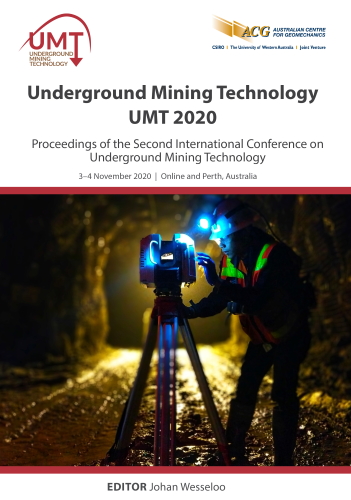Ground support strategy for optimisation of time schedule, Oyu Tolgoi Underground Mine

|
Authors: Batkhuu, B; Johnson, LA |
DOI https://doi.org/10.36487/ACG_repo/2035_19
Cite As:
Batkhuu, B & Johnson, LA 2020, 'Ground support strategy for optimisation of time schedule, Oyu Tolgoi Underground Mine', in J Wesseloo (ed.), UMT 2020: Proceedings of the Second International Conference on Underground Mining Technology, Australian Centre for Geomechanics, Perth, pp. 367-376, https://doi.org/10.36487/ACG_repo/2035_19
Abstract:
Oyu Tolgoi is an underground block cave in the initial development stage, where rapid development, yet comprehensive, ground support is required to begin undercutting and start production. High variability in the rock mass, high stress and deep mining requires various ground support standards and sequences to provide initial stability during development and long-term stability for the production stage. Different strategies were developed for ground support and reinforcement that support short-term and longterm stability at the appropriate time, to optimise the development rates and reduce rework. The different approaches considered the excavation ground conditions and size, the different short- and long-term purposes of drives, and the future interactions with other excavations and the undercutting. Management of the strategies required implementation of new or modified data management systems, such as Deswik® and CaveCAD, to collate data acquired from face mapping, drive scanning, and scheduling into a system that could be easily monitored and rapidly modified when required. Strategies were planned into the monthly and weekly schedules using Deswik® for initial and remaining ground support. Remaining ground support maps with attributes of support elements assisted short- and mid-term planning for scheduling ground support remaining against the design. Face mapping, overbreak, and support damage levels were monitored as trigger points to ensure that the appropriate level of ground support was installed at the required time, changing the strategy when required through daily reviews. The management of geotechnical data and the implementation of ground support strategies have optimised the mining cycles while ensuring that the ground was supported appropriately at the required time. The strategies have increased development and support rates, improving schedule compliance.
Keywords: ground support strategy, trigger points, secondary ground support
References:
Kaiser, PK, Diederichs, MS, Martin, CD, Sharp, J & Steiner, W 2000, ‘Underground Works in Hard Rock Tunnelling and Mining’, Proceedings of the International Conference on Geotechnical and Geological Engineering, Technomic, Chicago, pp. 841–926.
Laubscher, DH & Jakubec, J 2001, ‘The MRMR Rock Mass Classification for Jointed Rock Masses’, in WA Hustrulid & RL Bullock (eds), Underground Mining Methods: Engineering Fundamentals and International Case Studies, Society for Mining, Metallurgy, and Exploration, Inc., Littleton, pp. 475–481.
Oyu Tolgoi LLC 2016, Oyu Tolgoi Underground Feasibility Study, Oyu Tolgoi LLC, Ulaanbaatar.
Savage, E, Talu, S, Sturm, P & Van As, A 2016, ‘Development and implementation of the CaveCAD ground support module for cost and safety improvements in block cave mines’, Proceedings of the Seventh International Conference & Exhibition on Mass Mining, The Australasian Institute of Mining and Metallurgy, Melbourne, pp. 769–772.
Savage, E, Moorcroft, T & Talu, S 2018, 'Using a structured data management system to improve mine development efficiencies', in Y Potvin & J Jakubec (eds), Proceedings of the Fourth International Symposium on Block and Sublevel Caving, Australian Centre for Geomechanics, Perth,
© Copyright 2025, Australian Centre for Geomechanics (ACG), The University of Western Australia. All rights reserved.
View copyright/legal information
Please direct any queries or error reports to repository-acg@uwa.edu.au
View copyright/legal information
Please direct any queries or error reports to repository-acg@uwa.edu.au
